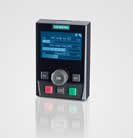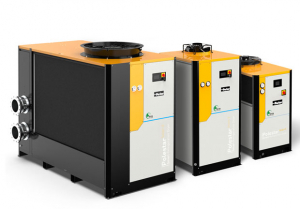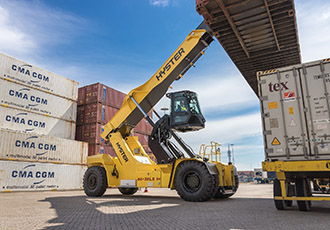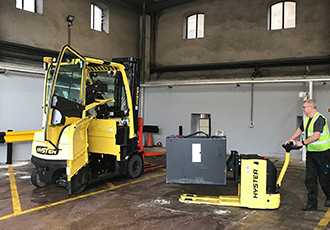Telsonic UK Seal the Case for Siemens
8th May 2009
Source:
Telsonic UK Limited

With a presence within the United Kingdom for 32 years, Telsonic UK Limited has been involved in a multitude of applications across a diverse range of industries and has subsequently acquired enviable levels of process and application knowledge. When Siemens presented the challenge of achieving an IP54 rated welded joint on an inverter operator panel, which incorporated sensitive electronics, Telsonic were once again able to demonstrate their ability to provide an innovative solution to a difficult welding application.
Dispelling the myth
Historically, it has been a design question whether ultrasonic welding and parts encapsulating electronic components are compatible, with concerns that the high frequency vibrations generated during the welding process can damage the sensitive electronic components. The Siemens plant in Congleton manufactures a range of components and solutions for drives and motion control. Engineers here were considering the use of ultrasonic welding for the first time on this site, as the joining method for the final assembly of an operator panel for a variable speed motor drive, but required re-assurance that the process would not induce problems with the internal electronics yet still achieve an IP54 rated welded joint.
The ability to draw on extensive field experience and fully utilise the advanced control features available within today’s ultrasonic welding machines are essential elements in the design risk evaluation for this type of application, and key factors in determining a successful process. Initial discussions with Siemens engineers focused on the evaluation of several different concepts, backed by visits to existing Telsonic customer sites to view similar applications and solutions.
The Siemens operator panel, at the stage in production where the welding must take place, comprises of 3 main components:- polycarbonate front and rear housings and a PCB. The assembly and subsequent welding of the rear housing to the front housing actually encapsulates and secures the PCB within the assembly. If ultrasonic welding was to be used as the joining method it was essential that the energy was directed into the joint and not allowed to dissipate into the features which retain the PCB within the assembly.
These stringent application requirements were reviewed by Telsonic UK Limited and the proposed solution focused on a highly efficient joint design. Telsonic worked closely with Siemens engineers to design and create an “Energy Director” joint as an integral part of the moulded case features, to create a finished closure which would achieve the required welding specifications and at the same time eliminate any possibilities of damaging the electronic components on the PCB. In this application the “Energy Director” joint required only 600 Joules(Ws) of energy to achieve the weld as opposed to around 1,000 Joules which would have been required with a more traditional hermetic weld seal joint. Having designed the joint configuration, tested the welding parameters and established the cycle time of 0.55 seconds, Telsonic then designed and built the production machine for Siemens.
Fully integrated solution including part traceability
The production system supplied by Telsonic for the Siemens application is based around a 20Khz, 3kw USP3000P ultrasonic welding system, complete with electronic proportional pneumatic control and a linear encoder, a configuration which allows the weld collapse height to be measured precisely. This, together with the reduction of 40% in the energy required to achieve the weld, guarantees that no excess energy is transmitted to other areas of the casing or the PCB. The Telsonic machine is also to be configured to produce 2 variants of the operator panel with the system storing the welding parameters for both product types. Parts are manually loaded to a precision welding fixture incorporated within a drawer mechanism. An array of sensors incorporated within the machine tooling is then used to verify that each of the individual parts has been correctly loaded before the welding process takes place. The system has been configured to ensure that the welding process does not take place before a bar code is allocated to the part. The system logic also eliminates the possibility of the same assembly being welded twice by mistake. The weld delivery result for each cycle is monitored by process control weld limits set within the MPS4 controller and subsequently included in the data string output to the Siemens system. A combination of warning indicators plus an operator panel allow clear and intuitive operation. The system is also completely guarded with an extruded aluminium frame and polycarbonate infill panels for safe operation.
Full process traceability is also a feature of this system, with the Telsonic machine designed and built to interface seamlessly with Siemens own hardware and bespoke internal quality IT application. The individual component bar code details, scanned prior to welding, are stored alongside weld result parameters, selected by Siemens and logged from the welding operation together with the time and date. At the end of each cycle this information is passed from the Telsonic MPS4 Weld Controller to the Siemens ‘’bench top controller’’ which comprises of an operator screen interface and PLC with Siemens application software, specifically designed to link to their SQL system. Five levels of password protection are available within the MPS4 controller to ensure that only trained and qualified individuals are able to adjust the various welding parameters such as:- weld set up, data set storage, initialisation settings and process control parameters.
With the system now in full production, Telsonic has shown that a combination of extensive applications knowledge, innovative ideas and a close working partnership with their customer can produce a system which meets or exceeds expectations. Furthermore, confidence in the use of ultrasonic welding technology by Siemens Congleton has increased significantly and the process, with its resultant benefits of speed, cleanliness and consistency, will be a prime candidate for future welding applications
Historically, it has been a design question whether ultrasonic welding and parts encapsulating electronic components are compatible, with concerns that the high frequency vibrations generated during the welding process can damage the sensitive electronic components. The Siemens plant in Congleton manufactures a range of components and solutions for drives and motion control. Engineers here were considering the use of ultrasonic welding for the first time on this site, as the joining method for the final assembly of an operator panel for a variable speed motor drive, but required re-assurance that the process would not induce problems with the internal electronics yet still achieve an IP54 rated welded joint.
The ability to draw on extensive field experience and fully utilise the advanced control features available within today’s ultrasonic welding machines are essential elements in the design risk evaluation for this type of application, and key factors in determining a successful process. Initial discussions with Siemens engineers focused on the evaluation of several different concepts, backed by visits to existing Telsonic customer sites to view similar applications and solutions.
The Siemens operator panel, at the stage in production where the welding must take place, comprises of 3 main components:- polycarbonate front and rear housings and a PCB. The assembly and subsequent welding of the rear housing to the front housing actually encapsulates and secures the PCB within the assembly. If ultrasonic welding was to be used as the joining method it was essential that the energy was directed into the joint and not allowed to dissipate into the features which retain the PCB within the assembly.
These stringent application requirements were reviewed by Telsonic UK Limited and the proposed solution focused on a highly efficient joint design. Telsonic worked closely with Siemens engineers to design and create an “Energy Director” joint as an integral part of the moulded case features, to create a finished closure which would achieve the required welding specifications and at the same time eliminate any possibilities of damaging the electronic components on the PCB. In this application the “Energy Director” joint required only 600 Joules(Ws) of energy to achieve the weld as opposed to around 1,000 Joules which would have been required with a more traditional hermetic weld seal joint. Having designed the joint configuration, tested the welding parameters and established the cycle time of 0.55 seconds, Telsonic then designed and built the production machine for Siemens.
Fully integrated solution including part traceability
The production system supplied by Telsonic for the Siemens application is based around a 20Khz, 3kw USP3000P ultrasonic welding system, complete with electronic proportional pneumatic control and a linear encoder, a configuration which allows the weld collapse height to be measured precisely. This, together with the reduction of 40% in the energy required to achieve the weld, guarantees that no excess energy is transmitted to other areas of the casing or the PCB. The Telsonic machine is also to be configured to produce 2 variants of the operator panel with the system storing the welding parameters for both product types. Parts are manually loaded to a precision welding fixture incorporated within a drawer mechanism. An array of sensors incorporated within the machine tooling is then used to verify that each of the individual parts has been correctly loaded before the welding process takes place. The system has been configured to ensure that the welding process does not take place before a bar code is allocated to the part. The system logic also eliminates the possibility of the same assembly being welded twice by mistake. The weld delivery result for each cycle is monitored by process control weld limits set within the MPS4 controller and subsequently included in the data string output to the Siemens system. A combination of warning indicators plus an operator panel allow clear and intuitive operation. The system is also completely guarded with an extruded aluminium frame and polycarbonate infill panels for safe operation.
Full process traceability is also a feature of this system, with the Telsonic machine designed and built to interface seamlessly with Siemens own hardware and bespoke internal quality IT application. The individual component bar code details, scanned prior to welding, are stored alongside weld result parameters, selected by Siemens and logged from the welding operation together with the time and date. At the end of each cycle this information is passed from the Telsonic MPS4 Weld Controller to the Siemens ‘’bench top controller’’ which comprises of an operator screen interface and PLC with Siemens application software, specifically designed to link to their SQL system. Five levels of password protection are available within the MPS4 controller to ensure that only trained and qualified individuals are able to adjust the various welding parameters such as:- weld set up, data set storage, initialisation settings and process control parameters.
With the system now in full production, Telsonic has shown that a combination of extensive applications knowledge, innovative ideas and a close working partnership with their customer can produce a system which meets or exceeds expectations. Furthermore, confidence in the use of ultrasonic welding technology by Siemens Congleton has increased significantly and the process, with its resultant benefits of speed, cleanliness and consistency, will be a prime candidate for future welding applications
Similar articles
More from Telsonic UK Limited
- Telsonic Showcase New Ultrasonic Packaging Technology at Total Processing & Packaging 2010 11th March 2010
- Telsonic UK Limited to Showcase New Technologies and Concepts at PDM 2010 11th March 2010
- Ultrasonic Welding - Design for Successful Production 7th March 2010
- Telsonic Keep Ultrasonics Safe and Sound 2nd December 2009




.jpg)







Write a comment
No comments